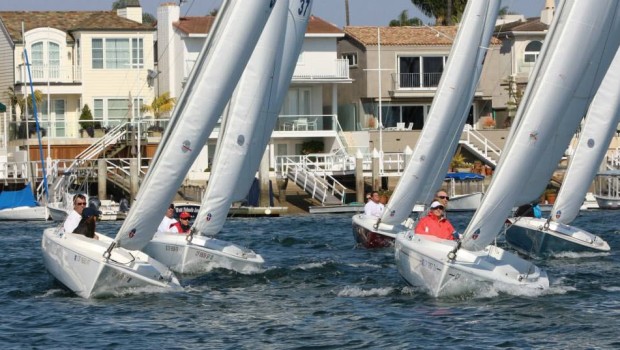Managing the Variables That Keep a Class Strong
Published on February 27th, 2014
While the J/70 speedster has generated tremendous enthusiasm, with 500+ sailing in 2014, another class has silently taken hold of a slightly different niche. The Harbor 20 blends simplicity with a competitive spirit, leading to 140 boats in Fleet 1 (Newport Beach, CA) and around 375 total boats in existence. The class rules set the tone:
“The Class intends to promote Class Racing at the highest level of racing skill that Corinthian sailors can realistically expect to attain. A Corinthian sailor races solely for personal pleasure. The Class intends that Corinthian sailors have a realistic chance of winning race prizes through their own efforts on the race course.”
Other rules such as mandatory cockpit cushions that you sit on while racing (torso must stay within cockpit) are consistent with the pursuit of the Corinthian spirit. This report by Len Bose sheds light on some of the other aspects that are working for this class…
Over time I have taken part in many fleets – from Hobie 16s, handicapped fleets, Schock 35s, Lido 14s and now Harbor 20s. During my involvement in these fleets I have taken away different lessons from each.
Like so many of us, my first exposure into the sport of sailing was racing Hobie 16s. This fleet had every component to keep sailing fun and its fleets healthy. In my view, its strength grew from within by supporting its D through A fleets. This, along with a camping environment, where everyone who attended these regattas would camp at the events together. This led to good times and fantastic social events.
In fact, I feel a lot of the class strength was because it was not based out of a yacht club environment. Class rules kept competitors from out-spending each other and race courses were less than five minutes from the beach.
Why did I leave the fleet? It was simple; I became too heavy and I could no longer compete. The boat is very physical from launching to hiking out. I can recall many windy regattas pitchpoling the boat and swinging out in front of the headstay and into the water. The speed was fun but it quickly became a young person’s game.
Today I have moved to the Harbor 20 and yes, I miss the times of spilling out of my Toyota camper shell like Jeff Spicoli from Fast Times at Ridgemont High. What has kept me so passionate about this fleet is that I can compete, at the highest level, with my son, wife or even my 75 year old father as crew.
One of the biggest lessons I learned, while sailing Lido 14’s, was that the strength of the fleet is in its B fleet members. One of the strongest features to the Harbor 20 fleet is that if you do not qualify to stay in A fleet, within a season, you must move down to B’s. This has kept the B fleet very strong. In fact, Fleet 1 in Newport Beach has now created a C fleet.
What happened in the Lido fleet was once you made it into A’s you did not have to go down to B’s. This kept the B fleet very small and all the attention was kept on the A’s. As a competitor there is only so long you can keep taking a beating from the top of the fleet before you lose interest.
The Harbor 20 fleet was very fortunate to be designed for Newport Harbor by a group of founding members that blended their past experiences into one of sailing’s best one design sailboats to date. With its class rules, a competitor will not be outspent by an opponent. Because the fleet can race in the harbor, the competitors are only 5 to 15 minutes from the race course. Because of its design, a skipper can sail by himself or with any of his family members, no matter what their age. Fleet 1 continues to promote social events from a summer party to a holiday awards banquet.
Keeping the class sailing, by the sailing rules, is also an important factor to the fleet’s success. The fleet grew very fast and in the beginning the rules where very, shall we say, relaxed. Bumper boats is what started to occur, and what everyone quickly experienced was the cost of gel coat repairs was not fun and very unhealthy for the fleet.
In an effort to improve the level of play, three rules seminars are offered each year. Members are encouraged to do their circle if they have fouled an opponent and discuss their opinion of the rules after racing. This alone has reduced the bumper boat syndrome by half and more ideas will be used this coming season. Such ideas are marking the three boat length circle to on-the-water umpiring and coaching during our summer races.
This fleet understands that a great deal of its strength will come from sailing youth. With a local effort towards team racing, the fleet continues to attract sailors from the age of 22 to 30 years.
All the variables keep lining up to keep the Harbor 20 fleet strong. I just cannot explain how fortunate I feel to be at the right place and time to take advantage of it.
Class website: www.harbor20.org
Fleet 1 Facebook page: www.facebook.com/Harbor20Fleet1









 We’ll keep your information safe.
We’ll keep your information safe.